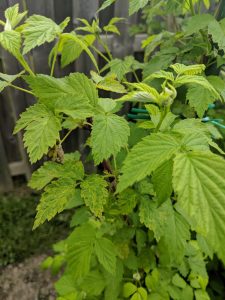
I have about 10 different varieties of raspberries in my Toronto yard. They were all planted last year as two year old canes. This spring I clipped back all of the two year canes planted last year and kept the fresh canes that started last year. I have noticed as the leaves have started to come in on the black jewel raspberries that they are splotchy with a bit of a brown around the edges. Is this an issue? I have been reading that it could be a virus. If so, should I remove the entire black jewel plant immediately and destroy it?
The canes are planted in clay soil, full sun, and fairly wet.
The browning edges of your raspberry plant could be caused by a number of things – nutrient deficiency, over fertilization, lack of water or diseases such as Rust fungus, Verticillium fungal infection or Raspberry mosaic virus. Below, you will find brief descriptions of each of these so that you can take a closer look at your plant, make a more accurate diagnosis and then decide on treatment or removal.
Nutrient Deficiency – leaves turn brown along the edges which is called Leaf burn. This can occur in raspberries when one or a number of essential nutrients are not readily available in the soil for the plant to take up. A soil test can determine which specific nutrient is needed. Other signs of nutrient deficiency include yellow / light green leaves & stems, yellowing between leaf veins, stunted growth and foliage loss. To help your plant regain its vigour, fertilize your raspberries with a balanced fertilizer (20-20-20) carefully following the directions for use on the fertilizer package. Ideally you should do this feeding in the spring when new growth emerges, then again in May and again at the end of June. Since the weather this year has been somewhat colder than usual, if you determine this is your problem, I would suggest doing a feeding now and then a second one at the end of the month.
Overfertilization – as stated above, fertilizer can fix nutrient deficiencies but raspberry leaf edges can become brown if too much fertilizer is applied. Other signs to look for include yellow & wilting leaves, slow or no growth, fertilizer buildup on the soil surface and leaf loss. In particular, nitrogen and chloride fertilizers can cause damage when applied too liberally. If you think this could be your problem, you may be able to save them if you flush the soil with water. Using your hose, give the soil around the plant a thorough soaking then allow the plant to drain. Do this several times leaving one hour between flushing’s.

